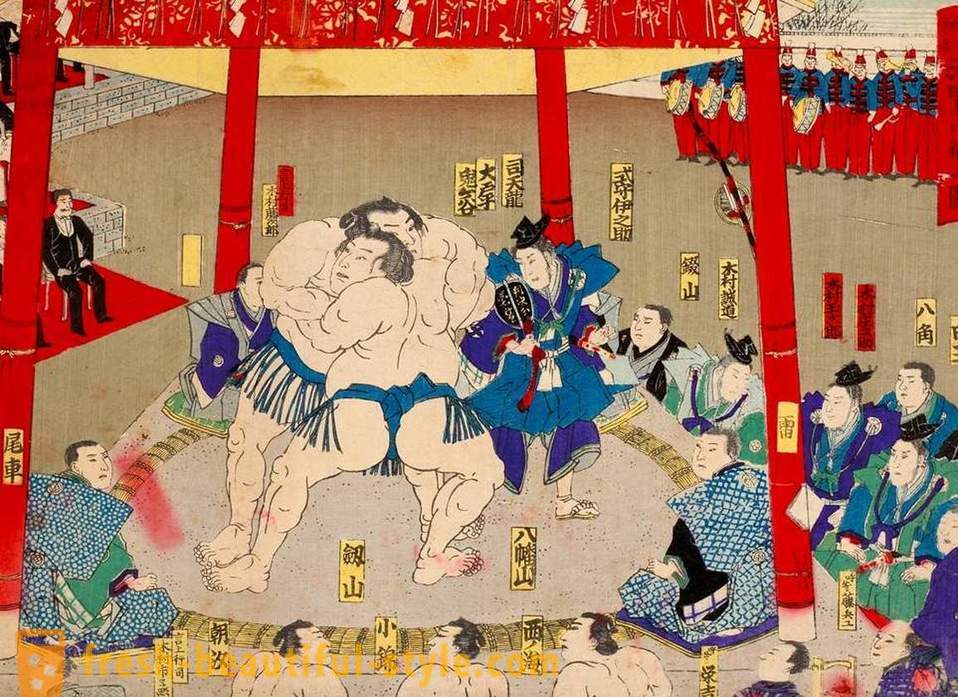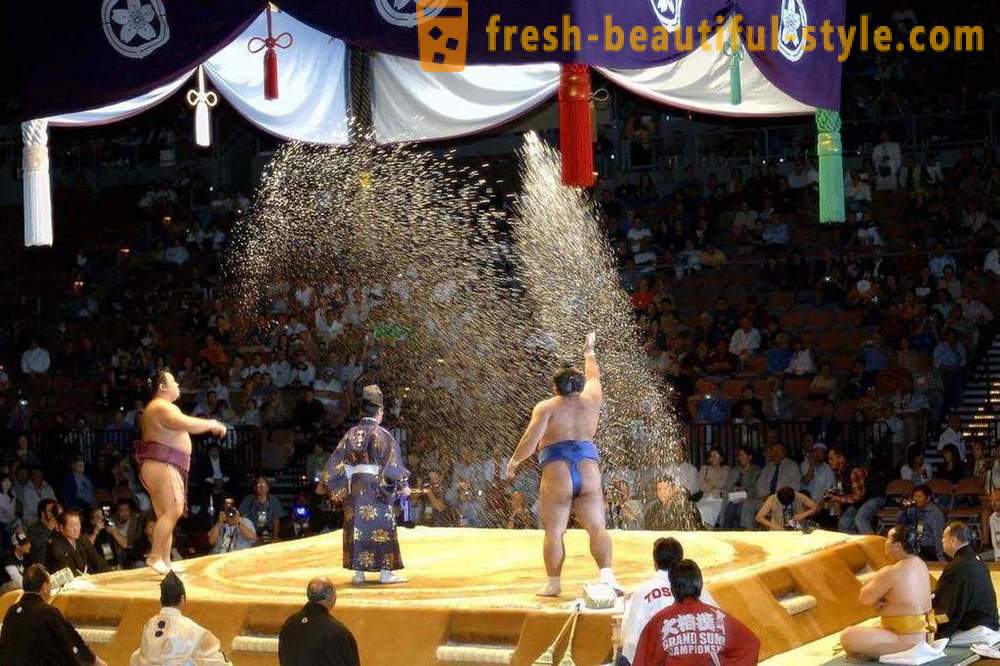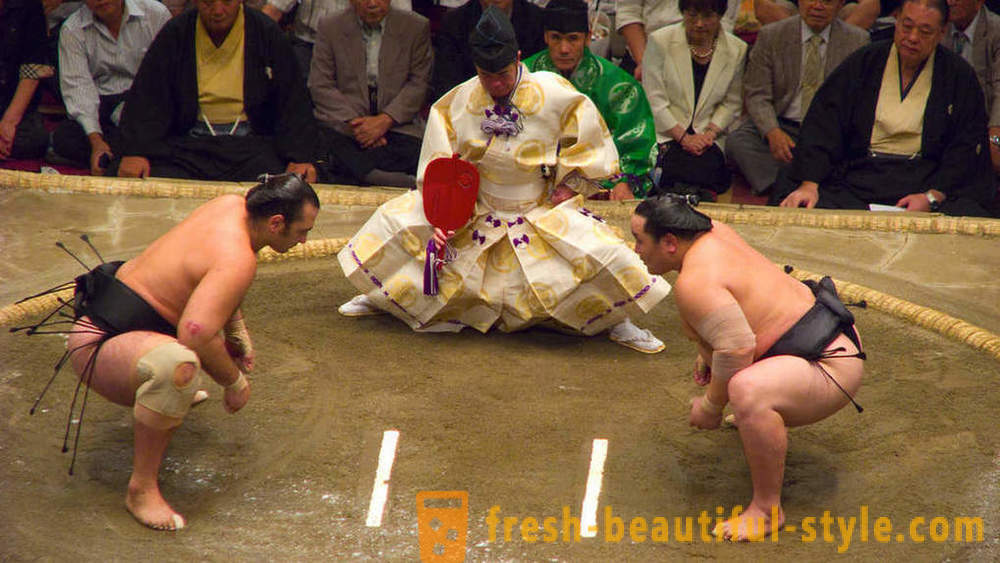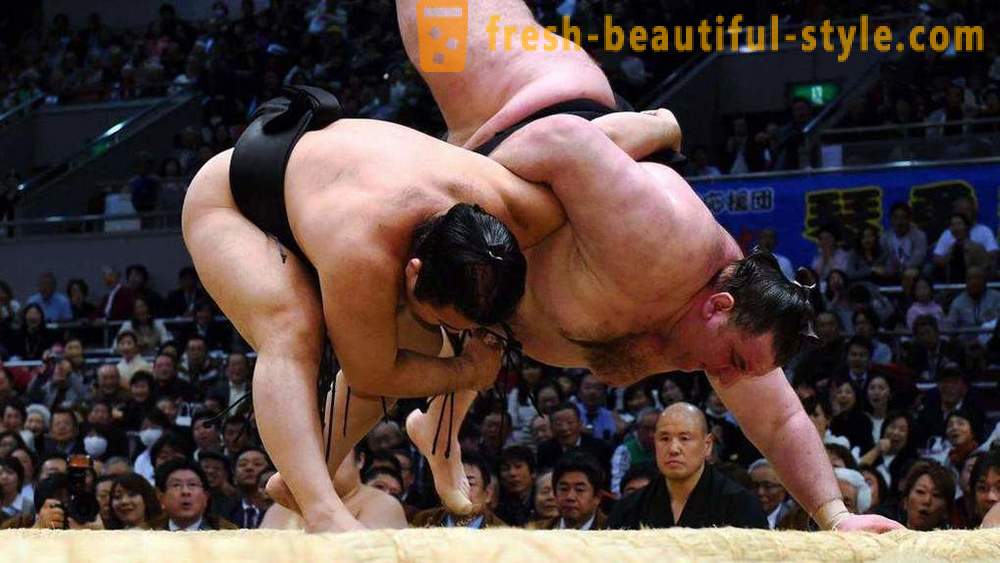Sumo Wrestling: history, rules, techniques and features the most interesting facts
At first glance it looks like a Japanese sumo wrestling strange men are overweight, dressed in bikini huge, jostling in a small circle, and a preliminary ceremony is usually longer than the fight itself. However, having dug a little deeper, you can find unique and technically a sport with a rich history and fighters, whose rigorous training regimen and dedication can not fail to impress.
Sumo - the kind of fight that has long been a national sport in Japan. Its origins date back to the Yayoi period (300 BC -.. 300 AD..). It includes a plurality of the Shinto religion in the form of various rituals and ceremonies that usually last much longer than most of the match. Until now, the competition in this sport is considered a sacred event, and the pavilion in which fights occur, equal to the Shinto shrine.
The origin and development of
The origins of sumo wrestling is lost in the mists of time, but it is believed it was first practiced in the Yayoi period as part of a Shinto ritual, when in battle were called "kami" or spirits.
Traditionally, the very first fighter is considered to Nomi no Sukune which Suyinin emperor (29 BC -.... '70 BC) commanded to fight, but Tagima Kehaem. Nomi no Sukune won, though natural, as a descendant of Amenohohi, the son of the goddess Amaterasu the sun.
Figures of sumo was surrounded by the oldest Japanese graves were also found depicting its clay toys Kofun period.
Wrestling sumo in Japan has become an important ritual in the VIII. n. e. In fights, known as Tsuji-dzumo participated samurai. They do not differ a lot of rules that often ends in death, and the prizes were cash. Another type of fights were kandzin-dzumo, which were held in the churches to raise money for their upkeep.

After the XII century this struggle has almost disappeared since the decline of the power of the Imperial Court and the emergence of the samurai class led to political instability. The last official Satie-sumo was held in 1174. When Shogun public matches were banned, but among the samurai martial arts encouraged. There are several paintings depicting people engaged in this kind of struggle in full gear offsite Doha. It is believed that the range that separates the champions from the audience, appeared in the XVI century. in the tournament organized by the main warlord Oda Nobunaga Japan. Then sumoists wore loose loincloths, rather than the much more stringent modern mawashi. In the Edo period during the fight the fighters were edged kese-mawashi, and today they are worn only during predturnirnyh rituals. Much of the rest of the sports form, used at that time, appeared in the same era.
The modern history of the rules and techniques of sumo wrestling began in Tomioka Hachimangu Shinto shrine in Tokyo. Regular fights are organized from 1684. In particular, the former samurai Ikadzuti Gondal established rules and an arena that is used to this day. sumo wrestlers, popularly called "rikishi", later to become professional athletes, but the struggle itself - the national sport. As before, it is still considered sacred.

Shinto rituals
Explosive physical shock in sumo wrestling is preceded by a long series of rituals and postures, which are derived from ancient Shinto religion and fights. One of such rituals is that the contestant raises one leg and repeatedly bashes it on the ground. He comes from the archaic practice of soldiers who committed such movements before the battle to frighten the enemy, which is called "Sicko." The same ritual is committed goddess Amaterasu, when it collided with a naughty brother Susanoo in Shinto mythology.
As fighters before the fight clap. This is another Shinto tradition that believes slams to mark the beginning and end of prayer.
Another ritual is that the athletes are periodically throw salt. It is an act of purification, which is practiced in Shinto shrines to drive away evil spirits.
Finally, a sumo referee of the match itself is a striking spectacle, because wearing a robe similar to those worn in medieval times in the Imperial Japanese court, and who today wear Shinto priests.
Golf fight
Two fighter looking at each other, standing on a square platform raised from compacted clay coated sand layer. Golf sumo wrestling width has dimensions exactly 5, 7 m on each side and a height of 34-60 cm. Ring represents a fur coat or a perfect circle diameter of 4 m 57, marked by braids made from rice straw. After each landing competitions understands. High above the raised platform canopy with colored tassels hanging from the 4 corners of it, and the whole ensemble has the status of a sacred Shinto shrines, which he closely resembles.

The winner of the bout must either push your opponent out of the circle of straw, or make him fall. If any part of the body of a fighter, but his feet, comes to the clay floor, he loses. Athletes with hair tied in a complicated knot imitation of medieval samurai, are "mawashi" or a large belt of which can grab the enemy to fight or raise its owner, pushing it beyond the circle or knocking. The fastest fights to perform this task may take only a few seconds, but the difficulty lies in the vast amount of fighters. Many sumoists weigh 150 kg, but the weights of individual giant may exceed 200 kg.
Company
Some sumo wrestlers in Japan are superstars, especially the winners of tournaments that have received the prestigious title of "yokozuna" or grand champion. However, participation in the sport is not only limited to the Japanese, because some yokozuna born in Mongolia, and Hawaii. Even less known sumoists are popular, as they are often invited into homes at the end of the winter, to rid the house of bad spirits, or "they" in a ceremony known as "setsubun" ( "the second day of the second month"). Sumo wrestler throws the beans and repeatedly shouts the phrase "they wa soto, fuku wa uchi", which means "the demons away, good luck come." Sumo in Japanese called "rikishi". Two characters that form the word means "power" and "warrior". At 6 leagues - Maku-uchi, Dzur, makushita, sandanme, dzonidan, dzonokuti - there are about 650 rikishi.
Maku-uchi (includes 42 best athlete), of course, gets the most media attention. At the top is a yokozuna, a great champion. This position usually occupied by winning two hon-bass (major tournaments that define the ranking) in a row. It held annually 6 hon-bass (in Tokyo, Osaka, Nagoya and Fukuoka), one in every odd month, and they continue for 15 days. By 2018, in the history of the sport it was only 72 yokozuna, which should give an idea of how difficult it is to achieve this title. Rikishi in the top two divisions (known as "sekitori") are fighting in every major tournament.
Preliminary ritual
The uniqueness of Japanese sumo wrestling is that the spectacular pre-match ceremony just as exciting as the fight itself. The day before each major tournament dohyo clay platform with a circle diameter of 4, 55 m, in which there is a match, "cleaned" with a prayer for the safety of rikishi. It involves placing salt, refined rice, dried chestnut, dried seaweed, dried cuttlefish and berries nutmeg in small pit in the center of the ring as an offering gods.
Rikishi climb to Doha from east and west, while the east side is doing it first. Fighters come out of the circle center and stop just behind the lines sikiri-sen, separated by only a few centimeters. They stare into each other's eyes and make a ritual called "Sicko." It lies in the fact that the wrestlers clap their hands and alternately raises and lowers the right and left legs, which probably is the action with which most associate this sport outside of Japan. But it's more than just warming up the muscles. Claps are used to attract the attention of the gods raised their hands to heaven demonstrate the lack of weapons, and the famous stomping their feet needed to crush any evil spirit. At the end of the circle and leave purify themselves Sicko rikishi. The first ritual is called "Qar-Mizu", which literally means "strong water". Each rikishi receives the water from the enemy, which they won last. Like a cleansing ritual in shrines and temples, each rikishi takes a handful of water, rinsed her mouth and body washes. Then the fighters take a handful of salt and throw it over the ring.

Duel
As soon as the referee gives the start signal shinpan battle, each rikishi crouches behind the white line length of 80 cm, called "sikiri-sen". Since sumo wrestling is designed for two participants, these two lines. The duel begins when both rikishi put fists at his sikiri-Sen.
Since it is the fighters themselves will eventually decide to start a fight, these moments can be incredibly stressful. Rikishi often squat for a few seconds, watching carefully, making their opponent, before getting up again. They can get out of the ring to his corner, but if they do, they must again clear circle with salt before re-entering. The winner is determined only fight (this is not the best system), and, as the first few seconds, during which the rikishi face, often decisive, we can understand why the preliminary steps are often the most intense moments of the fight.
If the judge determines that one of the contestants has not put both fists on the ground before the match or if the opponent decides that he is not quite ready, the bout is stopped. In this case, sumoists should return to its starting position.
Initial spurt tachi-ai is one of the most important stages of the match. Good start allows sumo fight in a style that suits him the most.
Officially there are 82 techniques known kimari-ones ( "decisive hand") with which rikishi can win the game (e.g., eject, stop, and so the neck. D.). Once a winner is determined, both rikishi are on either side of the circle and bow to each other, showing no emotion before the loser will leave the ring for sumo wrestling and shinpan officially announce the winner.

The total yield of the ring
Each day of the competition begins with the lower rank fights before the time comes to games Juri and Maku-uchi. Each round of fighting is preceded by a special process, called dohyo-iri, when rikishi are outside the circle of Doha, wearing his mawashi (silk loincloths), and perform an alternate version of Sicko ritual mentioned above. They clap their hands and rubbing their hands in order to make sure that the gods are watching, symbolically purifying before leaving the ring, waving his mawashi to show that underneath there is no weapon.
Yokozuna performs his own exit in the ritual circle, which is a more complex and long-lasting version of Sicko, which is also involved shinpan and two other rikishi present at Doha.
Rules of Engagement
The basic rule of sumo wrestling is simple: if any part of the body other than the feet, touches the ground or the athlete extends beyond the circle, the match ends and the opponent is declared the winner. During the fight the following actions are prohibited:
- grasping the hair;
- squeezing the eyes;
- punches (flip flops open palms are allowed);
- strangulation (although pushes open palms are allowed in the throat of the enemy);
- mawashi grip of the enemy in the crotch area.

The wrestler, who uses an illegal hold, automatically loses, as the one who untied mawashi. Also counted defeat to those who can not continue the fight (for example, after an injury). After the announcement of the winner must inform the judge about the reception that led to victory.
There are no weight classes. It's not just about size: agility can also be important, and small rikishi have the advantage that they can retreat and, slipping behind his larger opponent, used his considerable momentum against him.
The participation of foreigners and women
Although historically the sport was dominated by the Japanese, in recent years the usual participants in the competition becoming more and more foreigners Sumo. Rikishi who won the biggest victory in the tournament - Mongolian athlete named Hakuho Ce (Munhbatyn Davaadzhargal). Currently foreign (most of which are Mongolia) account for about 5% of total sumo.
In the professional sumo wrestling women can not participate. However, this prohibition does not apply to fans. Center for Women's sumo wrestling is considered Brazil.
Interesting Facts

The longest sumo match lasted 32 minutes, including 2 mizu-iri (short breaks that are declared when the fight comes to a standstill).
The greatest number of wins in a row - 69 - won Futabayama Sadadzi (1912-1968).
The heaviest sumo wrestler in history was orarion Satoshi - Russian athlete from the Republic of Buryatia, which borders with Mongolia, which weighed 271 kg.
Basic sumo wrestler shall be determined by his rank. Yokozuna receives about 2, 8 million yen per month, but the fighters Juri - about 1 million.
After a serious car accident involving an athlete Mitoidzumi Sumo Association banned sumo sit behind the wheel of a car.
Judges gedza like wrestlers come into the profession 16 years and remain there until retirement. Their traditional clothing is strongly dependent on rank, and as the professional development they receive honorary titles. Gedza highest rank takes its name Kimura Senosuke, but, in contrast to the yokozuna, wear it can only be one.
Each judge has a short sword tanto length of 15-30 cm. With it, he has to commit ritual suicide in the case of making a wrong decision.
In accordance with strict rules governing their life, sumo is forbidden to choose their own clothes. They need to grow hair to be able to engage them in a ten-MAGE assembly, similar to that which was in the samurai in the Edo period. This hairstyle as traditional clothing, sumo wrestlers must wear at all times. At the same clothes sumo beginners should be made of cheap cotton, and on their feet they have to be wooden geta sandals, even in winter. With increasing rank fighters are allowed to have more and more expensive clothes and even choose her own. Describing sumo wrestling, not to mention the basic diet of sumo - tyanko-nabe. It is rich in proteins Japanese stew consisting of fish, meat and vegetables in chicken broth, specially designed to help gain weight rikishi. Not necessarily have to be a fighter to try it - there are restaurants that specialize in this dish.













































